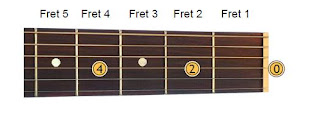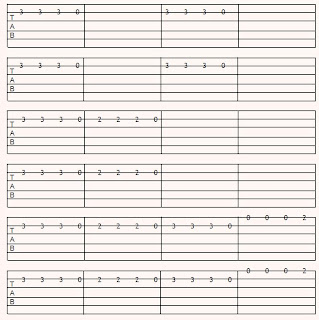Reading Guitar Tablature
Guitar tablature (also known as tab) is probably the easiest and most used method for guitar
notation
Use numbers to indicate the
string and the
fret position that you are supposed to play.
Each fret is numbered, starting at the nut of the guitar at O and moving upwards towards the
bridge of the guitar.
The 3 on the above tablature score (Tab. diagram 1) indicates to you that you place a finger
on the third fret of the sixth string. It is the note G.
The 1 on the above tablature score (Tab. diagram 2) indicates to you that you place a finger
on the first fret of the second string. It is the note C.
The O on the above tablature score (Tab. diagram 3) indicates to you that the third string is
to be played open. This means that you don’t need to place a finger on it. It is the note G.
Chords and Tablature
Chords are indicated by a set of numbers that tell you which frets need to be played and
which don’t
The A Major Chord
The first and fifth strings are played open while the second, third and fourth strings are
played at the second fret. The sixth string is not played in the A Major Chord and this is
indicated by an X.
Often tablature is written beneath traditional music score or stave. The two together look
like this:
























